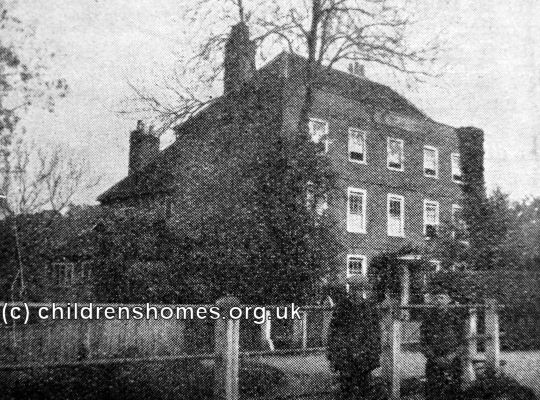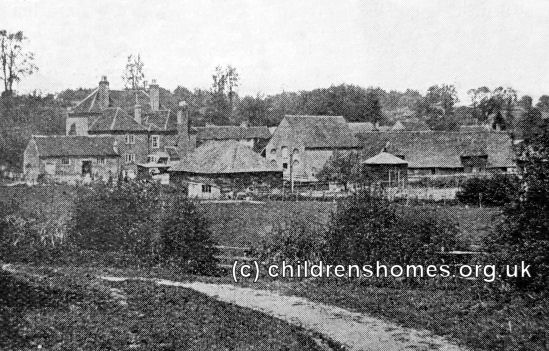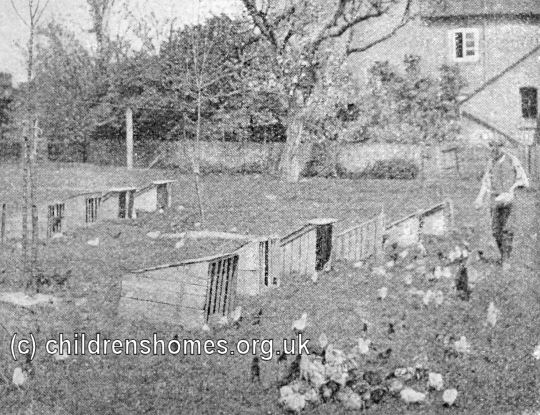Hedgerley Court Farm Home For Boys, Hedgerley, Buckinghamshire
The Hedgerley Court Farm Home For Boys, a Waifs and Strays Society home, was established in 1893 at Village Lane, Hedgerley, Buckinghamshire. It was officially opened on June 22nd of that year by the Leslie Randall, the Bishop of Reading. The property, which included thirty acres of land, was let to the Society at a nominal rent of five shillings per annum by Mrs Henry Stevenson of Scotton Hall, Richmond Yorkshire, and of Hedgerley Park. It provided accommodation for 25 boys, aged from 12 to 16.

Hedgerley Court Farm Home entrance, c.1923. © Peter Higginbotham

Hedgerley Court Farm Home from the south-east, c.1924. © Peter Higginbotham

Hedgerley Court Farm Home from the south-east, c.1903. © Peter Higginbotham

Hedgerley Court Farm Home from the north-east, c.1903. © Peter Higginbotham
Like its sister establishments at Caversham and Standon, the Hedgerley home took older boys who were taught farming skills such as the cultivation of crops, market gardening, the rearing of sheep, cows and poultry, the production of milk, sheep-shearing etc.

Hedgerley Court Farm Home gardening, c.1913. © Peter Higginbotham

Hedgerley Court Farm Home feeding chickens, c.1903. © Peter Higginbotham

Hedgerley Court Farm Home pigs and chickens, c.1903. © Peter Higginbotham

Hedgerley Court Farm Home barns and cows, c.1903. © Peter Higginbotham

Hedgerley Court Farm Home boys with a cow, c.1924. © Peter Higginbotham

Hedgerley Court Farm Home harvest time, c.1925. © Peter Higginbotham
As well as their outdoor labours, the boys helped with domestic chores such as the home's weekly laundry.

Hedgerley Court Farm Home laundry, c.1903. © Peter Higginbotham
Indoor activities in the winter included basket-making.

Hedgerley Court Farm Home making baskets, c.1903. © Peter Higginbotham

Hedgerley Court Farm Home making baskets, c.1915. © Peter Higginbotham
During the First World War, the boys turned their hand to making sandbags.

Hedgerley Court Farm Home making baskets, c.1915. © Peter Higginbotham
Many of the home's boys were destined for emigration to Canada, where they were found employment on farms.

Hedgerley Court Farm Home, Canadian emigrants, c.1895. © Peter Higginbotham

Last day at Hedgerley Court Farm Home, Canadian emigrants, 1910. © Peter Higginbotham

Hedgerley Court Farm Home, Canadian emigrants, 1924 © Peter Higginbotham
It appears that boys at the home sometimes put on their own entertainments, such as a pierrot show at Christmas in 1907.

Hedgerley Court Farm Home pierrots, Christmas 1907. © Peter Higginbotham
The increasing cost of maintaining the buildings, together with the ending of Canadian emigration for boys below working age, led to the home's closure in 1926.
The property is now privately owned.
Records
Note: many repositories impose a closure period of up to 100 years for records identifying individuals. Before travelling a long distance, always check that the records you want to consult will be available.
- Index of the Society's first 30,000 children's case files ordered by surname.
- Index of the Society's first 30,000 children's case files ordered by date of birth.
- The Children's Society Records and Archive Centre is at Unit 25, Springfield House, 5 Tyssen Street, London E8 2LZ (email: archives@childrenssociety.org.uk). Files for children admitted to its homes after September 1926 were microfilmed in the 1980s and the originals destroyed. Some post-1926 files had already been damaged or destroyed during a flood. The Society's Post-Adoption and Care Service provides access to records, information, advice, birth record counselling, tracing and intermediary service for people who were in care or adopted through the Society.
- The Society has produced detailed catalogues of its records relating to disabled children, and of records relating to the Children's Union (a fundraising body mostly supported from the contributions of children).
Bibliography
- Bowder, Bill Children First: a photo-history of England's children in need (1980, Mowbray)
- Church of England Waifs and Strays' Society [Rudolfe, Edward de Montjoie] The First Forty Years: a chronicle of the Church of England Waifs and Strays' Society 1881-1920 (1922, Church of England Waifs and Strays' Society / S.P.C.K.)
- Higginbotham, Peter Children's Homes: A History of Institutional Care for Britain's Young (2017, Pen & Sword)
- Morris, Lester The Violets Are Mine: Tales of an Unwanted Orphan (2011, Xlibris Corporation) — memoir of a boy growing up in several of the Society's homes (Princes Risborough, Ashdon, Hunstanton, Leicester) in the 1940s and 50s.
- Rudolf, Mildred de Montjoie Everybody's Children: the story of the Church of England Children's Society 1921-1948 (1950, OUP)
- Stroud, John Thirteen Penny Stamps: the story of the Church of England Children's Society (Waifs and Strays) from 1881 to the 1970s (1971, Hodder and Stoughton)
Links
- Hidden Lives Revealed — the story of the children who were in the care of The Children's Society in late Victorian and early 20th Century Britain.
- The Children's Society
Except where indicated, this page () © Peter Higginbotham. Contents may not be reproduced without permission.


